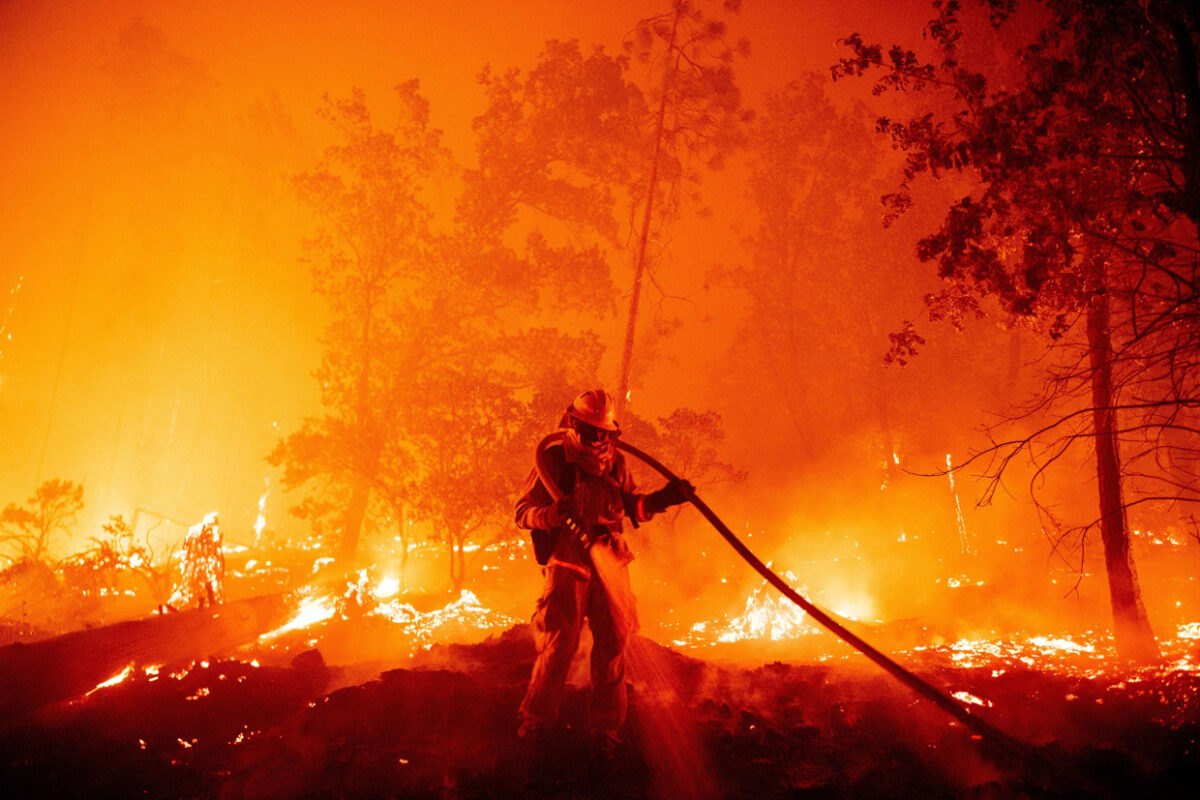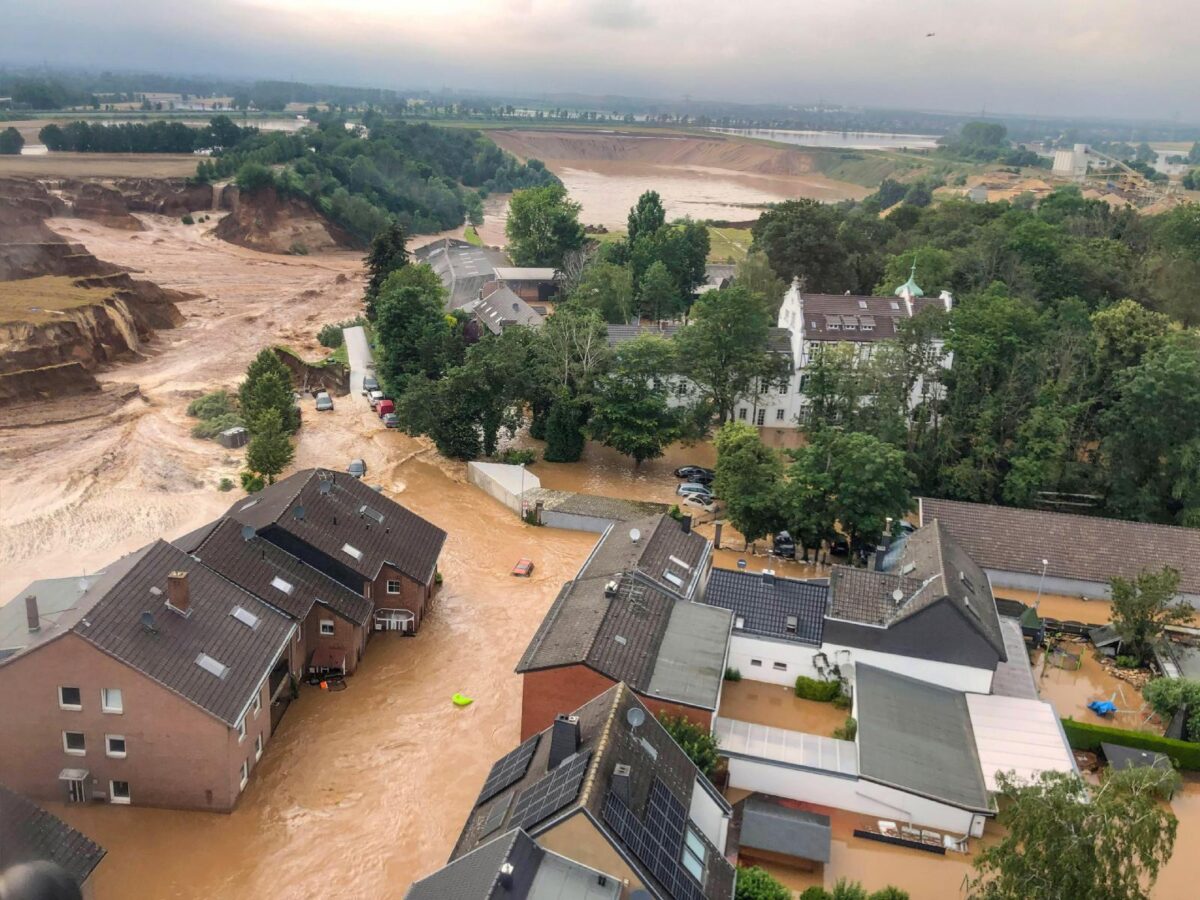
Earth Hanging in the Balance – A New American Journal graphic by Walter Simon [Art Market Place]
By Glynn Wilson –
WASHINGTON, D.C. — Back in the 1980s, into the 1990s and as recently as this year, scientists, science writers and environmental activists warned people and governments that human industrial activity fueled a catastrophic greenhouse effect that was warming the planet and changing the climate.
The United Nations led the early warning system, and said in a report back when that if people and governments did not act collectively to slow the burning of fossil fuels for energy, the consequences would be “profound” for humans and nature.
Well, “The scientists were right,” according to The Washington Post, which broke the first story out Monday on a new report from the Intergovernmental Panel on Climate Change.
It describes in more detail than ever before how industrial activity has altered the natural environment at an “unprecedented” pace, and provides details on some of the “catastrophic” impacts that are coming — unless the world dramatically and rapidly begins to cut greenhouse gas emissions.
The report leaves no room for any remaining scientific doubt about humans fueling global warming and climate change. It is “unequivocal” in that conclusion, leaving no room for partisan politics to stand in the way any longer in convincing the people to get on board and act.
“The only real uncertainty that remains, its authors say, is whether the world can muster the will to stave off a darker future than the one it already has carved in stone,” as the Post puts it.
I announcing the report, U.N. Secretary General António Guterres called the findings “a code red for humanity” and said societies must find ways to embrace the transformational changes necessary to limit warming as much as possible.
“We owe this to the entire human family,” he said in a statement. “There is no time for delay and no room for excuses.”

A firefighter douses flames as they push towards homes during the Creek fire in the Cascadel Woods area of unincorporated Madera County, Calif.: Josh Edelson
A total of 234 authors rely on more than 14,000 studies from around the planet in the report, laying out in stark detail the most up-to-date understanding of the physical science on climate change for policymakers and the public. I comes in the hottest month of the hottest summer ever while heat waves fuel deadly fires covering much of the American West and other parts of the world, as deadly floods appear in other parts of the world.
In three months, a critical summit will take place in Scotland, where world leaders face mounting pressure to move more urgently to slow the Earth’s warming.
While governments and industries here and there have taken steps to try to curb the worst emissions, the moves so far to slow climate change has proved “gravely insufficient.” Instead of the sort of emission cuts that scientists say must take place, global greenhouse gas pollution is still going up, not down.
Most countries failed to meet the targets they set under the 2015 Paris climate accord, the one abandoned by President Donald Trump, meaning the United States lost four critical years in being part of the solution. We also lost eight years back when George W. Bush was president, as he turned over energy policy to Dick Cheney’s Council on Competitiveness and the oil and gas companies.
“Even the bolder pledges that some nations recently have embraced still leave the world on a perilous path,” according to the Post.
“What the world requires now is real action,” John F. Kerry, the Biden administration’s special envoy for climate, said in a statement about Monday’s findings. “We can get to the low carbon economy we urgently need, but time is not on our side.”

An areal view shows flooding in Erftstadt-Blessem, Germany, July 16, 2021. Rhein-Erft-Kreis, Reuters
Humans can unleash less than 500 additional gigatons of carbon dioxide — the equivalent of about 10 years of current global emissions — to have an even chance of limiting warming to 1.5 degrees Celsius (2.7 Fahrenheit) above preindustrial levels. The world has already warmed more than 1 degree Celsius (1.8 degrees Fahrenheit), with few signs of slowing, and could pass the 1.5-degree mark early in the 2030s.
Any hope of for remaining below that threshold — the most ambitious goal outlined in the Paris agreement — are slipping away as people go about their business of driving gas guzzling automobiles and power companies continue to burn coal and fight environmental regulations.
“Unless we make immediate, rapid and large-scale reductions in greenhouse gas emissions, limiting warming to 1.5C will be beyond reach,” said Ko Barrett, vice chair of the IPCC and senior adviser for climate at the National Oceanic and Atmospheric Administration. “Each bit of warming will intensify the impacts we are likely to see.”
We are living on a changed and changing planet already, and people are beginning to see it with their own eyes.
Each of the past four decades has been warmer than any that came before. Dating back to records kept since 1850, humans have warmed the planet at a rate unparalleled since before the fall of the Roman Empire. To find a time when the level of carbon dioxide in the atmosphere changed this much this fast, you would need to rewind 66 million years to the end of the age of the dinosaurs.
Carbon dioxide in the atmosphere has risen to levels not seen in 2 million years, the authors state. The oceans are turning acidic. Sea levels continue to rise. Arctic ice is disintegrating. Weather-related disasters are growing more extreme and affecting every region of the world.
Psychological research shows that climate change can alter an individual’s mental health both directly and indirectly, impacting how we respond to this crisis.
If the planet warms much more than 2 degrees Celsius above preindustrial levels — a scenario all but certain at the current pace of emissions — such change could trigger the inexorable collapse of the Greenland ice sheet and more than six feet of sea-level rise that could swamp coastal communities. Coral reefs would virtually disappear.
Heat waves that are already deadly will become as much as 5 degrees Fahrenheit hotter. Parts of the Earth that currently slow the pace of warming — such as the ocean absorbing excess heat and clouds reflecting sunlight back into space — will become less able to help us.
“The chances of unknown unknowns become increasingly large,” said Zeke Hausfather, director of climate and energy at the Breakthrough Institute and a contributor to Monday’s report. “We don’t have any great comparable analogues in the last 2 million years or so. It’s harder for us to predict exactly what will happen to the Earth’s systems.”
‘Established Fact’
The evidence for humanity’s influence on the climate system, once a fiercely debated topic, is now “overwhelming,” the IPCC report states. What began as a scientific hypothesis has become “established fact.”
That deepening certainty shows up not only in the changing composition of the atmosphere and the rising temperature of the oceans, but in signs large and small, from the dwindling of Arctic sea ice to the ever-earlier blossoming of Japan’s famous cherry trees.
The report’s 42-page “summary for policymakers” uses the phrase “virtually certain” nearly a dozen times. The words “high confidence” come up more than 100 times. The rate of sea-level rise, the retreat of ice sheets and glaciers, and the acidity of the oceans are all described as “unprecedented” in the past several thousand years.
Georgia Tech climate scientist Kim Cobb, one of the lead authors, said an array of new observational data from satellites and weather stations has given scientists more details about the Earth’s inner workings than ever before.
Equally important are the unmistakable real-world effects of climate change. Last year rivaled the hottest year in recorded history. Communities around the world have been battered by heat waves, droughts, hurricanes and wildfires so extreme that they cannot be explained by mere natural variability.
“The signals are just leaping out of the noise,” Cobb said.
Using sophisticated computer models, researchers are increasingly able to pinpoint the role of climate change in particular natural disasters, sometimes within days or weeks of the event.
Storms such as Houston’s Hurricane Harvey in 2017 and Tropical Cyclone Idai, which killed hundreds of people in Mozambique two years later, bore the unmistakable fingerprints of human-caused warming. The additional heat in the oceans provides more energy for storms, the report says, making intense Category 4 and 5 hurricanes more likely. Warmer air holds more moisture, increasing the amount of rain that falls during these events.
Likewise, scientists say the intense fires and blistering heat waves that have become summertime fixtures in both hemispheres would be almost impossible in a world unaltered by human activities. Warming has increased the “thirstiness” of the air, driving catastrophic wildfires in California and Australia over the past several years.
“It’s now become actually quite obvious to people what is happening, because we see it with our own eyes,” said Corinne Le Quéré, a professor of climate science at the University of East Anglia and a contributor to Monday’s assessment. “You don’t have to have a PhD. You don’t need to be a climate scientist. You just need to be a person who looks out the window.”
‘Uncharted Territory’
The IPCC, a science-focused collection of experts from around the globe, does not issue policy recommendations. Monday’s report is merely the first of several scheduled between now and 2022 assessing the mounting effects of climate change and evaluating what it would take for humans to limit warming.
But the report does detail the likely consequences of varying emissions scenarios, drawing on decades of meteorological observations, sophisticated computer models and examples of past warming drawn from the geologic record.
In the best-case scenario, the world rapidly phases out fossil fuels, embraces renewable energy on a massive scale and overhauls how humans work, eat and travel.
People eliminate emissions of carbon dioxide from coal, oil and gas. Societies find a way to curb powerful but short-lived greenhouse gases — most notably methane, which largely comes from burping cows and leaky fossil fuel facilities, and nitrous oxide, of which a huge amount comes from fertilizers used on farms. Natural systems such as forests and human inventions such as carbon-capture operations pull more and more out of the atmosphere.
In this scenario, the world reaches “net-zero” emissions around the year 2050, and warming stabilizes at about 1.5 degrees Celsius above preindustrial levels. Eventually, glaciers stop dwindling and sea-level rise slows. Humans adapt to the changed planet.
But with each degree of temperature rise, the consequences become dramatically more extreme, scientists underscored once again.
At 2 degrees Celsius above preindustrial levels, air can hold significantly more moisture than it does now, making droughts more likely and extreme rainfall worse. At 4 degrees Celsius (7.2 degrees Fahrenheit), intense heat waves that used to occur about once every 50 years will become annual events.
Mercifully, Monday’s assessment shows, the world for now seems to be trending away from the most ruinous potential path, as coal-fired power fades, renewable energy increasingly takes root and investors and voters alike demand climate-conscious policies.
But nations have not yet moved quickly enough to meet the Paris agreement goal to remain “well below” 2 degrees Celsius of warming.
At higher levels of warming, the report warns, it becomes much more difficult to predict how the planet will respond. Sophisticated computer models become uncertain. Scientists cannot easily seek clues in the past, because there is no recorded time in human history when change has been so extreme — and so fast.
“We’re going into uncharted territory,” Cobb said.
The more people emit, the greater chance of changes that take centuries or millennia to undo. Already, ocean acidification will persist even if the amount of carbon dioxide in the atmosphere declines. At a certain point, the Greenland ice sheet will become so weak it moves into a state of irreversible decline.
Warming beyond 2 degrees Celsius also carries increased risk of setting off feedback processes that cause climate change to accelerate. Higher temperatures will thaw Arctic permafrost, potentially unleashing carbon that has been locked in a deep freeze for thousands of years. Methane trapped in the deep sea could make its way into the atmosphere. Wildfires could turn millions more acres of carbon-rich forests into a source of additional greenhouse gases. Air quality in many places could continue to worsen.
The more the climate changes from the one in which humans evolved and modern science was developed, the more likely we are to encounter challenges that exceed our capacity to adapt.
“We really don’t want to experience it,” cautioned lead author Fredi Otto, a climate scientist at the University of Oxford who studies weather extremes.
The IPCC report does not recommend specific warming targets. But as someone who has seen how societies already struggle to cope with climate disasters, Otto urged policymakers to take the difficult steps necessary to limit warming to 1.5 degrees Celsius.
“It will be difficult,” she acknowledged. “But it’s still within our power to do this.”
‘Every Little Bit Counts’
The report underscores that humans have a profound opportunity to shape a better future by sharply reducing emissions. But it also spells out how we can no longer avoid some measure of calamity in coming years.
The oceans will continue warming to 2100 and beyond, the authors warn. Shrinking seasonal snow cover across the Northern Hemisphere is all but certain. The rate of sea-level rise is increasing and is destined to continue in coming decades. The likelihood and severity of extreme hot weather “will occur throughout the 21st century.”
How rapidly those changes unfold depends on how much humans continue to spew greenhouse gases into the atmosphere, the authors make clear. But even the most optimistic scenarios assume that emissions will continue over the next two decades, leading to higher and higher carbon dioxide concentrations in the atmosphere. And it may take several decades after humans begin shrinking their collective carbon footprint before the impacts of those changes are felt.
Yet greenhouse gases that are emitted now could be more difficult to remove later. The report cautions that declining carbon dioxide levels in the air could cause the land and oceans to release carbon it has absorbed. Efforts to pull carbon out of the atmosphere — using natural systems, like reforestation, or mechanical solutions, like machines that store the gas in rocks — probably will require huge amounts of time and energy.
In 2019, global emissions stood higher than in any other year in human history. The drop in pollution caused by economic shutdowns at the start of the coronavirus pandemic proved to be only a blip. Now the world is back on track to emit as much as ever, careening toward an ever hotter and more unpredictable future.
“Every place we look, we are seeing the evidence of past inaction. That should be a wake-up call,” said Jane Lubchenco, deputy director for climate and environment at the White House Office of Science and Technology Policy. “We need to do everything possible to avoid even worse disaster.”
The report generated an avalanche of similar reactions, with scientific groups, elected officials and activists from around the world saying leaders can no longer wait to act, given that the scientific evidence about the risks of worsening climate change are clearer than ever.
Meanwhile, the heaviest burdens from climate change have long fallen on the world’s most vulnerable, and on nations that played little role in causing climate change but can least afford to adapt.
For low-lying islands, rising seas present an ongoing and existential threat. Crippling floods have led to deaths and displacement for hundreds of thousands of people, from Sudan to Uganda. People who are unhoused, impoverished or sick are disproportionately likely to suffer in weather extremes. These disparities will only intensify as the planet continues to warm.
But recent disasters also show that climate impacts can hit without regard for national borders, income level and political clout. The Midwest this month is choking on smoke from wildfires hundreds of miles away in Canada. Germany, one of the world’s wealthiest nations, suffered billions in damage from July’s floods that killed scores of people.
The findings are grim, acknowledged lead author Claudia Tebaldi, a scientist at the Pacific Northwest National Laboratory. But people should not dwell in regret for the failures of the past, Tebaldi said, or only despair over possibilities that are not yet inescapable. Instead, she urged people to focus on what can still be done, on what can still be salvaged.
After all, the hard math of science shows that a concerted push by governments and the private sector can still bend the world’s troubling trajectory. Each action to slow the pace of emissions gives society more time to adapt to changes we know are coming. Each degree of warming that humans avoid saves us from climate catastrophes that don’t have to happen.
“Things are going to change for the worse. But they can change less for the worse than they would have, if we are able to limit our footprint now,” Tebaldi said. “Every little bit counts.”
Before you continue, I’d like to ask if you could support our independent journalism as we head into one of the most critical news periods of our time in 2024.
The New American Journal is deeply dedicated to uncovering the escalating threats to our democracy and holding those in power accountable. With a turbulent presidential race and the possibility of an even more extreme Trump presidency on the horizon, the need for independent, credible journalism that emphasizes the importance of the upcoming election for our nation and planet has never been greater.
However, a small group of billionaire owners control a significant portion of the information that reaches the public. We are different. We don’t have a billionaire owner or shareholders. Our journalism is created to serve the public interest, not to generate profit. Unlike much of the U.S. media, which often falls into the trap of false equivalence in the name of neutrality, we strive to highlight the lies of powerful individuals and institutions, showing how misinformation and demagoguery can harm democracy.
Our journalists provide context, investigate, and bring to light the critical stories of our time, from election integrity threats to the worsening climate crisis and complex international conflicts. As a news organization with a strong voice, we offer a unique, outsider perspective that is often missing in American media.
Thanks to our unique reader-supported model, you can access the New American journal without encountering a paywall. This is possible because of readers like you. Your support keeps us independent, free from external influences, and accessible to everyone, regardless of their ability to pay for news.
Please help if you can.
American journalists need your help more than ever as forces amass against the free press and democracy itself. We must not let the crypto-fascists and the AI bots take over.
See the latest GoFundMe campaign here or click on this image.
Don't forget to listen to the new song and video.
Just because we are not featured on cable TV news talk shows, or TikTok videos, does not mean we are not getting out there in search engines and social media sites. We consistently get over a million hits a month.
Click to Advertise Here















